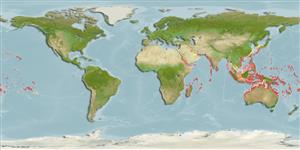Common names from other countries
Classification / Names / Names
ماع يماسا | فدارتم | Catalog of Fishes (gen., sp.) | ITIS | CoL | WoRMS
Environment: milieu / climate zone / depth range / distribution range
يسانش موب
گنس بآ هب هتسباو; قمع تارييغت 0 - 30 m (Ref. 349). Tropical; 37°N - 32°S, 29°E - 127°W
Indo-Pacific: from eastern Africa to Sudan, Egypt, Yemen and India, to southeast Asia and Australia, as far east to Pitcairn Islands and north to Hawaii and Japan. Tropical to subtropical.
Length at first maturity / Size / Weight / نس
Maturity: Lm ? range ? - ? cm Max length : 43.0 cm SHL يسنج صاوخ نودب / رن سنج; (Ref. 349); common length : 28.0 cm SHL يسنج صاوخ نودب / رن سنج; (Ref. 349)
Actively collected by native populations for food, by hand at low tide on the reefs, or by diving. In spite of its weight and considerable size, the shell is favored, especially by tourists, due to the beauty of its heavily glazed aperture (Ref. 349). Found on sand near rocks and corals (Ref. 130068).
Life cycle and mating behavior
غولب | لثم دیلوت | یزیر مخت | اه مخت | Fecundity | )ورال ( دازوت
Members of the order Neotaenioglossa are mostly gonochoric and broadcast spawners. Life cycle: Embryos develop into planktonic trocophore larvae and later into juvenile veligers before becoming fully grown adults.
یلصا ذخآم
عجارم | هدننك گنهامه | ناراكمه
Poutiers, J.M. 1998. (Ref. 349)
NCUI زمرق تسرهف رد تيعضو (Ref. 130435)
ستياس رظن زا تيعضو (Ref. 108899)
Not Evaluated
Not Evaluated
اه ناسنا یارب رطخ
Harmless
یناسنا هدافتسا
تاليش – يريگ يهام: يراجت
| FishSource | Sea Around Us
اهرازبا
رتشيب تاعالطا
Age/Size
دشر
نزو - لوط
لوط - لوط
يسانش تخير
)ورال ( دازوت
يناوارف
يتنرتنيا عبانم
Estimates based on models
Preferred temperature
(Ref.
115969): 24.8 - 29.3, mean 28.4 (based on 3207 cells).
یريذپ بيسآ
Low to moderate vulnerability (33 of 100).
تميق هقبط
Unknown.
